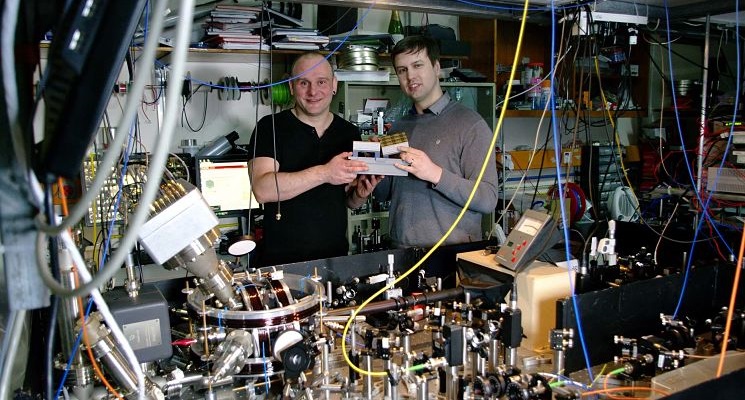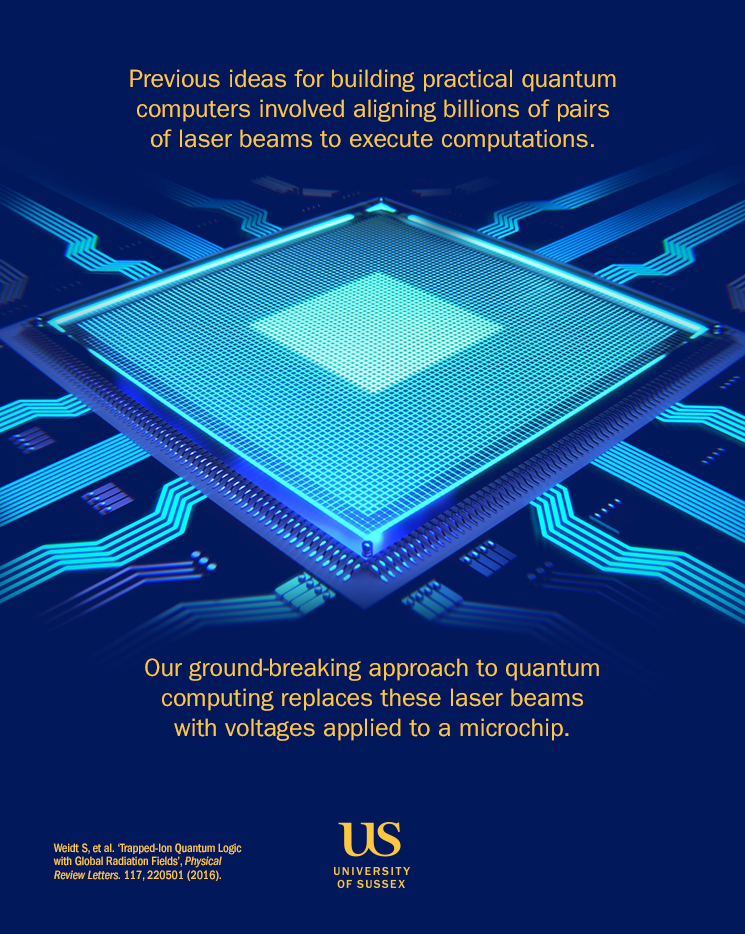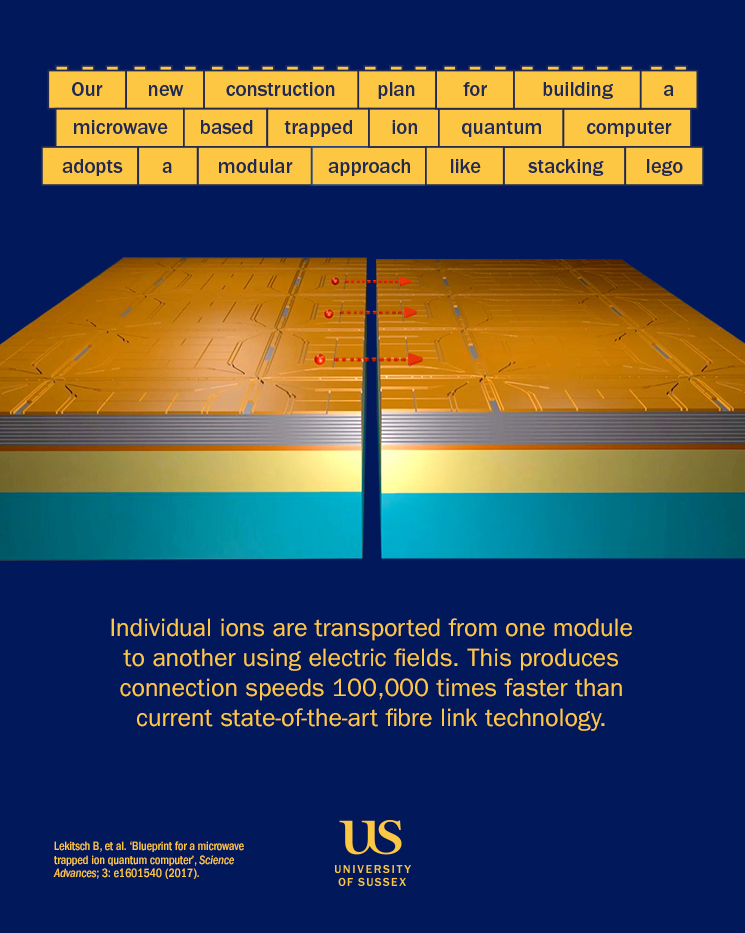Building a prototype for the world’s first large-scale quantum computer
Scientists at the University of Sussex have developed the world’s first blue print for building a quantum computer, which has been made public so scientists can further develop the groundbreaking technology.
 Prof Winfried Hensinger and Dr Bjoern Lekitsch with a model of their prototype.
Prof Winfried Hensinger and Dr Bjoern Lekitsch with a model of their prototype.
Computers are arguably one of mankind’s most important inventions. In the last 50 years they have transformed the way we live. From mobile phones to life support systems and data processing to food production, it’s hard to conceive of life without them. So imagine what we could achieve with a computer capable of processing data that would take even the fastest supercomputer a billion years to calculate?
Scientists have known for some time that a quantum computer has the potential to revolutionise industry, science and commerce. Using the principles of quantum physics, a quantum computer will work at incredible speed, helping to create lifesaving medicines, unravel the mysteries of deepest space and solving problems that an ordinary computer is just not powerful enough to calculate.
Previously the stuff of science fiction, the race is now on to develop the first practical model. We know how to build a quantum computer in principle, but in reality the technological challenges are immense. Quantum computing on a small scale, using trapped ions, is carried out by aligning individual laser beams onto individual ions, with each ion forming a quantum bit. So on a larger scale, we would need billions of quantum bits, requiring billions of precisely aligned lasers.
Large-scale quantum computer within reach
But now scientists at the University of Sussex have invented a much simpler, ground-breaking method that places the construction of a large-scale quantum computer within reach of current technology. The method applies voltages to a quantum computer microchip, without having to align laser beams.

- Large-scale quantum computer within reach (text version)
Previous ideas for building practical quantum computers involved aligning billions of pairs of laser beams to execute computations.
Our ground-breaking approach to quantum computing replaces these laser beams with voltages applied to a microchip.
Weidt S, et al. 'Trapped-Ion Quantum Logic with Global Radiation Fields', Physical Review Letters. 117, 220501 (2016).
The technique is the work of an international collaboration led by researchers at Sussex, and including scientists from Google US, Aarhus University in Denmark, RIKEN research institute in Japan and Siegen University in Germany.
‘For many years, people said that it was completely impossible to construct an actual quantum computer’ said Professor Winfried Hensinger, Director of the Sussex Centre for Quantum Technologies and research lead for the project. ‘With our work we have not only shown that it can be done but we’ve delivered a nuts and bolts construction plan to build an actual large-scale machine. And now we’re building a prototype based on this design.’ Like the first mainframe computers from the 50s, which took up whole rooms, the first quantum computer will be huge, and could even be the size of a football pitch.
For many years people said that it was completely impossible to construct an actual quantum computer. With our work we have not only shown it can be done but we've delivered a nuts and bolts construction plan to build an actual large-scale machine.” Professor Winfried hensinger
Director of the Sussex Centre for Quantum Technologies
Being in two places at once
Classic computers use binary code to operate. A quantum computer uses atoms to encode information. In quantum theory atoms behave differently when treated in certain ways. So the process known as superposition is based on the mind-boggling principles that an atom can be in two different places at the same time; entanglement is the process where by two atoms can be in some way connected despite being vast distances apart; the process known as tunnelling is when an atom can move through a solid object.
Winfried and his team are harnessing these very strange effects, building a computer using individual modules. This new invention allows actual quantum bits to be transmitted between individual modules in order to obtain a fully modular large-scale machine capable of reaching nearly arbitrary large computational processing powers.

- Construction plan for building a quantum computer (text version)
Our new construction plan for building a microwave based trapped ion quantum computer adopts a modular approach like stacking lego.
Individual ions are transported from one module to another using electric fields. This produces connection speeds 100,000 times faster than current state-of-the-art fibre link technology.
Lekitsch B, et al. 'Blueprint for a microwave trapped ion quantum computer', Science Advances; 3: e1601540 (2017).
Scientists had previously suggested using fibre optic connections to connect individual models. The new approach introduces connections by electric fields that allow ions to be transported from one module to another, producing 100,000 times faster connection speeds between individual quantum computing modules compared to current state-of-the-art fibre link technology.
The research is part of the UK Government’s National Quantum Technology Programme, a £270 million investment to accelerate the translation of quantum technologies into the marketplace.
Blueprint made public
When we think of the possible applications of a quantum computer, Winfried suggests that we need to think of this technology in the same way as when the first computers emerged in the 1950s. No-one could even begin to guess at their full potential.
The same thing is true for quantum computers. ‘It’s not just about the speed of computing they offer,’ he says. ‘They’ll allow us to do things we haven’t even dreamed are possible, from different ways of making pharmaceuticals or creating new materials to developing capabilities that may revolutionise the financial sector. They have the potential to change our understanding of biological processes and even of life itself.’
But for Winfried this research isn’t purely about scientific curiosity. It’s about using the technology for the betterment of the world. ‘For me, it’s about discovering something really amazing for humankind and then making it a reality.’
The team’s blueprint for developing a large-scale quantum computer has been made public to ensure scientists throughout the world can collaborate and further develop this brilliant technology.
Winfried says, ‘The availability of a universal quantum computer may have a fundamental impact on society as a whole. Without doubt it is still challenging to build a large-scale machine, but now is the time to translate academic excellence into actual application, building on the UK’s strengths in the technology.
‘We are very excited to work with industry and government to make this happen. Together with scientists from around the world, and our outstanding scientists at Sussex, we are ready to make a large-scale quantum computer. We can make it happen.’
Read the full paper: Blueprint for a microwave trapped ion quantum computer
Contact us
Research development enquiries:
researchexternal@sussex.ac.uk
Research impact enquiries:
rqi@sussex.ac.uk
Research governance enquiries:
rgoffice@sussex.ac.uk
Doctoral study enquiries:
doctoralschool@sussex.ac.uk
Undergraduate research enquiries:
undergraduate-research@sussex.ac.uk
General press enquiries:
press@sussex.ac.uk